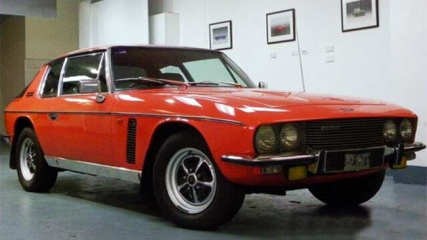Used Jensen Interceptor, HSV Commodore and De Tomaso Longchamp review: 1983-1990
By Stuart Martin · 02 Apr 2013
If capped priced servicing sounds like cheating, modern car design is just too damned homogenous to your eyes, then some left-field classics might get the blood pumping.Trawling the darkened depths of the Carsguide website found some interesting old - and some not so old “time” machines on the market.For the price of a mid-spec four-cylinder small car there are vehicles on the market that stand well apart from the shopping-trolley crowd.As beefy Brits go this is one of the beefiest - the Jensen Interceptor was a four-seater grand-tourer with a Chrysler V8 under its elongated snout.Only a handful - in global terms - were built in the UK during the 1960s and 1970s, and some made it to Australia, so the chances of seeing one driving the other way are minimal.The rounded rump was a distinctive look for the Jensen and it also had the distinction of being the first all-wheel drive sports coupe.Glass's Guide says the rear-wheel and four-wheel drive models were available here from 1970 through until 1976 (when imports ceased) in the 6.2-litre and 7.2-litre forms, hooked up to a three-speed automatic and priced at a little over $22,000 when they were new - Holden had the HQ Monaro on offer around the same time and its retail price ranged from $3800 for the 4.2-litre V8 manual to just under $5000 for the 5.8-litre three-speed automatic model - nowadays, mint versions of the latter can fetch upwards of $60,000.De Tomaso is one of those interesting Italian brands - born in 1959, it was involved in motorsport (including a brief and nasty stint in F1) as well as owning brands like Bugatti and Ducati.It went into liquidation in 2004 and was briefly back in business before controversy again had the brand in trouble and it was up for sale in 2012 - it keeps threatening a 21st century revival.The two-door Longchamp was born from the same chassis and drivetrain as the Deauville four-door, using a 243kW/440Nm 5.8-litre Ford Cleveland V8 that also powered the more svelte Pantera.A top speed of well over 200km/h and an opulent interior were among the car's highlights, but given its $65,000 new pricetag it want to have plenty.A total of 409 Longchamps were built (395 coupes and 14 spiders) until 1989, with only a couple per year built during the final years.One for the locals - while many remember the much-be-spoilered Walkinshaw VL SS Group A (with a 180kW/380Nm five-litre V8 and priced at $45,000) that kicked off the Brit's relationship with Holden Special Vehicles.The red VL SS Group A was the last Commodore produced by Peter Brock's Holden Dealer Team - Holden's relationship with Brock went sour in 1987 after Brock and his crew came up with a device known as an “Energy Polariser” and fitted it, as well as other features not tested by Holden.There was a little less hoopla when the VN version popped up in 1990, sporting a $68,950 asking price in the showrooms, it packed a 210kW/400Nm five-litre V8 hooked up to a six-speed ZF gearbox (borrowed from the Chev Corvette), weighed in about 200kg heavier but was draped in less-polarising (if you'll pardon the Brock pun) bodykit styling.Track versions of the car were reportedly quicker in a straight line but not as good on the bends as the VL's bodykit actually worked, providing downforce.The VN was the final Group A, part of the era of Australian production-based touring car racing that was slaughtered by the all-conquering Nissan GT-R.The build-run never made it to the planned 500, with 302 seeing the light of day, based on a Berlina but fitted with a Momo leather-wrapped steering wheel, velour interior trim, sports seats and instruments, Bilstein dampers, a limited slip diff and a Mongoose remote control alarm.1970 Jensen Interceptor coupePrice: $24,990Engine: 7.2-litre V8Transmission: 3-speed autoThirst: 20L/100kmOdometer: 78,547kmThe big Jensen coupe was rare and expensive car when it was new - it sold new for just over $22,000 but was hand-built and had airconditioning, alloy wheels and power windows. At the time it was more than double the cost of a V12 E-Type Jag and at least four times the price of an HQ Monaro. Such is the profile of the odd British beast, it was even featured as a classic car in the Gran Turismo 4 game.Phone: 02 9119 54021983 De Tomaso Longchamp 2+2Price: $30,000Engine: 5.8-litre V8Transmission: 4-spd autoOdometer: 23,000km The Italian luxo-coupe with a muscular Aussie heart - the engines were sourced for the car from Australia when the US sources for the beefy V8 dried up, and Australia supplied the engines until V8 production ceased in the late 1980s. Hooked up to a four-speed auto, the Longchamp has air conditioning, power steering, power windows,remote central locking, cruise control among its leather-trimmed interior - when new it sold for $65,000, which was about the same money being asked for a Mercedes-Benz 380 SE V8 sedan.Phone: 07 3188 05441990 HSV VN Commodore SS Group APrice: $58,990Engine: 5-litre V8Transmission: 6-speed manualOdometer: 152,364kmThirst: 16l/100kmNot as famous as the VL but a genuine Aussie musclecar nonetheless, the HSV VN SS Group A popped up with a six-speed manual (a vague but strong gearbox borrowed from the Corvette) as well as upgraded brakes and bodykit. Capable of a sprint to 100km/h in 6.5 seconds and a 14.5-second quarter-mile, this example is number 83 of a planned 500-car build run, but the economy brought it to a halt at 302. The VN Group A SS came with air conditioning, a Mongoose alarm, 17in alloy wheels, cruise control, central locking, a limited slip diff and a chunky Momo leather steering wheel.Phone: 02 9119 5606










